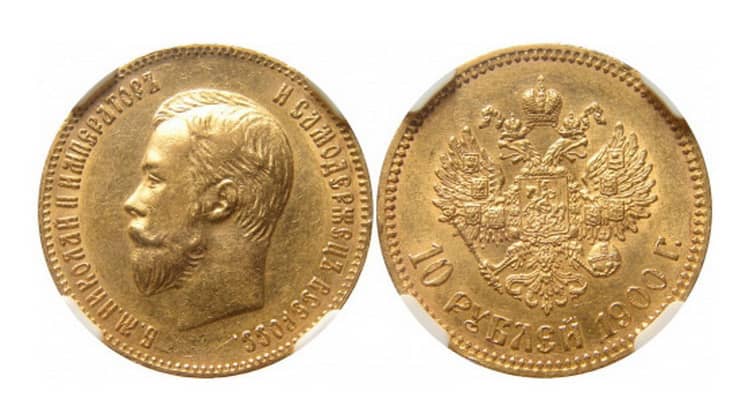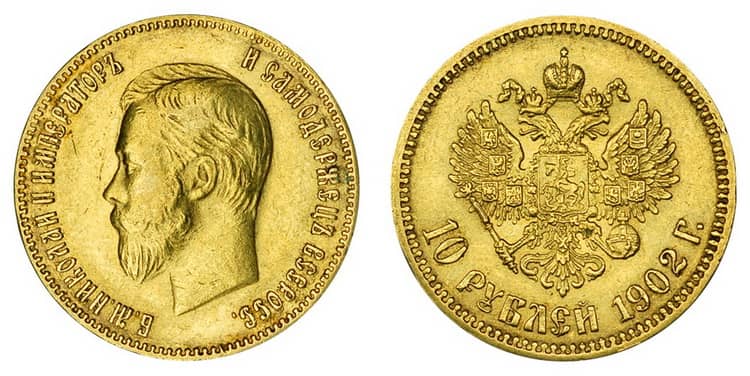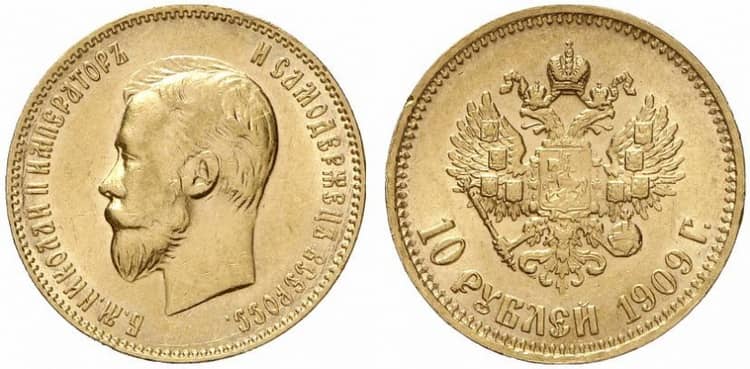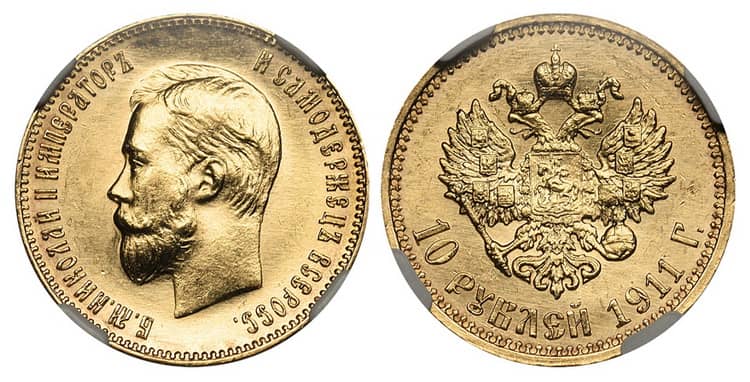
10 rubles coins (1898-1911) are the part of cultural and historical heritage of the country. Their mintage is connected with interesting and important stages in the development of the monetary business in Tsarist Russia and therefore each of them is a pride of any collection. The chervontsy of Nicholas II era can differ in cost. It depends on the year of coinage and the preservation of coins.
History
At the end of the XIX century, Russia underwent a financial reform led by S. Yu. Witte. The reason for the reform was the instability of the monetary system, its goal was not only the internal strengthening of the ruble, but also the external one due to free exchange for gold. The correct decisions of the Minister of Finance had led to the fact that the prestige of the domestic economy significantly increased, and led to investment development and foreign capital inflows.
Did you know? The ruble was originally a measure for value and weight, but not a coined currency (apart from the ruble an altyn, a dime, couple dozen were used for trade). Gold coins were minted in 1756, and then in 1779. Along with them appeared unchangeable bills – paper money. Under Nicholas II, the ruble was restored as the main unit of account and the trade currency.
To solve the problem, Russia introduced the gold coin standard according to the principle that existed in many European countries. The standard was required due to the emergence of united world market. Russia was trading with foreign countries, therefore, like partners, needed a similar monetary system. Due to this, new monetary denominations had appeared in the country – the coins of 10 and 5 rubles (1897-1911). This measure helped to stabilize paper and metal currency.

The reform required to reduce the turnover of banknotes and increase the production of gold coins. In the early years, the Russian Mint did not cope with the coinage according to the established plan, so the Mints of Belgium, France and Japan were involved to production.
The number of minted coins of 10 rubles was 18 times more than before the reform.
The monetary reform implied a reduction in the weight of the coin due to the rise in value of the precious metal. Previously, the total weight of the coin was 12.9 grams, after the reform the weight decreased by 4.3 grams and became 8.6 grams. Before that, the heavy 10 rubles were called “Imperial” (5 rubles − half-imperial). In 1898, the last 400 samples were minted (according to another version only 125), and then the imperial was withdrawn from production. The new weight-reduced coin was called “chervonets”.
Did you know? According to the Bloomberg agency, currently the richest man on the planet is Jeff Bezos. His net worth is 151 billion dollars. Tsar Nicholas II was also in the list of the richest people in the early period (from the end of the 15th century to the present day). The emperor occupied the fourth place. He was estimated to own about 250-300 billion dollars (based on the rate of 2010).
Some people mistakenly call 10-ruble coins as the imperial and the royal chervonets. The first version was minted in limited edition in 1897, and the release of the second one reached 10,000,000. They also differed in weight, so their cost is significantly distinctive. The imperials have investment and collector’s value. Tsarist chervonets of 1898 are slightly more expensive than the gold price or equal to the investment coin of 50 rubles with Saint George the Victorious.

Together with the monetary reform of increasing the number of gold coins and reducing their weight, S. Yu. Witte suggested to give coins a new name. Instead of the usual “ruble”, new samples were called “rus”. A pilot party consisted 5, 10 and 15 rubles (5 sets of three samples were produced). Tsar Nicholas II did not support the idea and the coins retained their former name.
Currently, you may find 10 rubles coins in both good (AU, XF), and bad quality (VF, F, VG) at auctions. Often you may come across the coins of Proof and Uncirculated quality. New tsarist chervontsy (novodels) in the perfect state are mostly a fake, which outwardly correspond to the original. A lot of mysterious stories are connected with this feature:
- the stamp was stolen from the Mint during the revolution and exported abroad, only there the mintage was proceeded
• the stamp was stolen and copied, then it was taken abroad, and the production of fake coins began
• the stamp was taken away by General Kolchak who continued to mint 10 rubles to support the White Army
• the Soviet government did not have the money to create a stamp and purchase the equipment, so they continued to produce the old samples.
In the world of numismatists, novodels are valued not less than the original 10 rubles of the Nicholas II period, but they differ significantly both in appearance and in value. Among the chervontsy there are interesting samples, for example the coins of 1899 with a portrait of the Tsar, which is typical for coins of 1900-1911.
Did you know? According to the Russian legislation of the Imperial Era, each member of the Romanov family was given an annual “basic income”. Since 1884, when Nicholas received the status of “Tsesarevich” (heir to the Russian throne), a 16-year-old future ruler was given a scholarship of 100,000 rubles. In 1894, when he became an Emperor, this sum doubled. It is known that in 1896 his personal funds amounted to approximately two million rubles and 355,000 francs.
Thus, in total there are 4 types of 10 rubles 1898-1911:
• imperials
• ruses
• chervontsy
•novodels
All coins of this denomination are interesting for collectors due to unusual stories related to production, as well as the fact that each sample is made of gold, which means that it has a great potential.
Design
10 rubles of 1898-1911 made of 900 gold standard (so that the coins retain their appearance longer and less wear out). The obverse and the reverse side are similar in different periods − on the circumference there is a protruding edge with inwardly-shaped prong in the form of the Greek letter “omega” (Ω).
Obverse: side-face of Nicholas II, turned to the left. In the left there is an inscription in semicircle ” Б.М.НИКОЛАЙ II ИМПЕРАТОРЪ ” (” Б.M.” means “By the grace of God”). On the right around the circumference along the edge there is the inscription ” И САМОДЕРЖЕЦЪ ВСЕРОСС “.

Reverse: there is a two-headed eagle with a scepter and power in its paws in the center. On the wings there are the emblems of the main cities of the Russian Empire. Heads of eagles are crowned, above them there is the Russian crown. On the chest of the bird is placed the Moscow arms. Under the eagle there is the inscription “10 РУБЛЕЙ” and the year of coinage. On the edge of the coin there is a decorative edging with prongs.
Did you know? On the modern gold and silver coins of Russia the double-headed eagle is also minted, but there are no crowns on the image.
Coin edge: the inscription ” ЧИСТАГО ЗОЛОТА 1 ЗОЛОТНИК ЧИСТАГО ЗОЛОТА 1 ЗОЛОТНИКЪ 78,24 ДОЛЕЙ “.

The initials of the mint master changed through the years:
• Apollo Grasgoff (AG) – 1895-1899;
• Elikum Babayants (EB) – 1899, 1906-1913;
• Felix Zaleman (FZ) – 1899-1901;
• Alexander Redko (AR) – 1901-1905.
This feature allows you to distinguish a fake from the original, as well as determine the cost of 10 rubles. In the catalogs, the price of the chervonets of Nicholas II period with “FZ”, “EB” is slightly higher than for coins with the initials of “AG”.
Circulation
• 1898 – 200 000 pcs.
• 1899 – 27 600 000 pcs.
• 1900 – 6,000,000 pcs.
• 1901 – 2 400 000 pcs.
• 1902 – 2 000 000 pcs.
• 1903 – 2,800,000 pcs.
• 1904 – 1 000 000 pcs.
• 1905 – not minted
• 1906 – 10 coins
• 1907 – not minted
• 1908 – not minted
• 1909 – unknown
• 1910 – 100,000 pcs.
• 1911 – 50,000 pcs.
Did you know? Tsar Nicholas II had been receiving an annual scholarship of 200,000 rubles, which included “pocket money” (Nikolas often exceeded this amount, and sometimes spent less than 150,000 rubles). “Pocket money” was used to buy clothes and personal items, such as soap, shaving cream and tobacco. The same amount of money was spent on charity, the purchase of gifts and decorations appointed by the Tsar, as well as buying books, magazines and works of art.
Price of coins
The price of 10 rubles depends of various factors:
- Circulation
- Preservation
- Mint master
Even bad preserved sample can not be less than 285 $ USD (due to gold weight). Therefore, for example the cost of 10 rubles in the quality XF and AU is 476 $ USD, UNC is 750$, Proof is 4300 $ USD.
Comments
No commens yet.